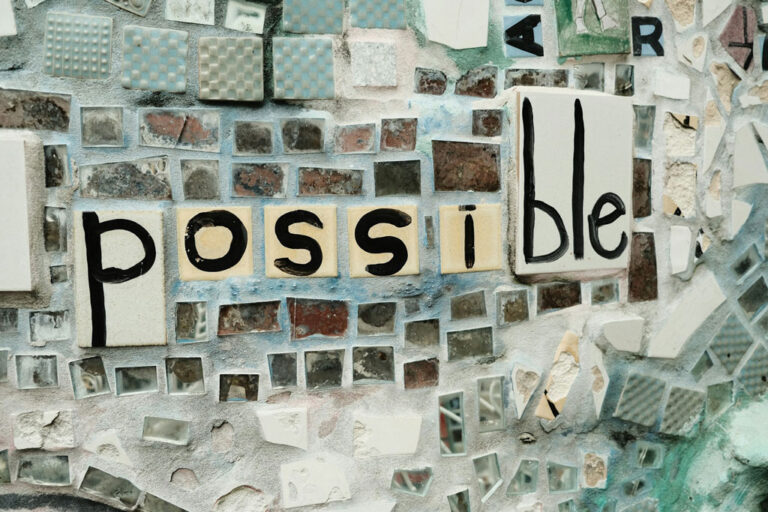Newsletter – April 2015
PRESIDENT’S COLUMN
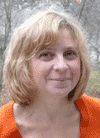
The Costs (and Benefits?) of Constant Counting
By Mona Domosh
I’m a 24; well, only on Google scholar (the more inclusive research “platform”). Otherwise, on Thomson Reuters’ Web of Science, I’m a 12. For those fluent in the language of academic metrics you will know immediately what I am referring to: my h-index, a number that is calculated based on the subset of my publications such that h publications have been cited h times. In other words, according to Google scholar, I have 24 publications that have been cited 24 times. The h-index, therefore, provides a shorthand metric of academic “success,” a way of combining an assessment of productivity and purported impact all in one number. Continue Reading
Recent columns from the President
Get the Most From Your AAG Annual Meeting Experience with the Mobile App
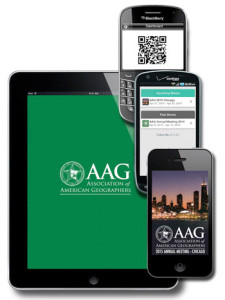 The AAG mobile app will help you balance your schedule of preferred sessions, events and meetings with friends and colleagues, while keeping you informed with daily Geograms and social media updates. Networking features offer colleagues tools to share schedules and exchange contact information.
The AAG mobile app will help you balance your schedule of preferred sessions, events and meetings with friends and colleagues, while keeping you informed with daily Geograms and social media updates. Networking features offer colleagues tools to share schedules and exchange contact information.
The AAG mobile app also integrates with social media networks on Twitter, Facebook, and LinkedIn. And, it will help you collect and share important notes and information from sessions and exhibitors.
ANNUAL MEETING
Illinois Secretary of Education to Speak at Annual Meeting
Beth Purvis, Secretary of Education of the State of Illinois, will be a featured speaker during an AAG Annual Meeting panel on K-12 policy. The session will be held on Friday, April 24, from 8:00 – 9:40 a.m. and speakers representing various U.S. Senate and House offices have also been invited. The panel will focus primarily on the possibility of Congressional reauthorization of the Elementary and Secondary Education Act (ESEA; currently known as No Child Left Behind) in 2015 and related opportunities for geography. Learn More.
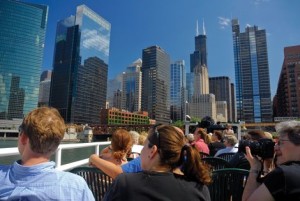 Family Activities in Chicago
Family Activities in Chicago
Learn, explore, and enjoy Chicago with the family
By Euan Hague
Within a few minutes walk of the Hyatt, there are a number of museums and things to do with children. The best place to start your visit to Chicago is downtown at the Cultural Center. Not only does the Center offer free art exhibitions and musical performances, often at lunch times or early evenings, it is also the site of Chicago’s main tourism information office. The Cultural Center has spectacular interior decoration, including a Tiffany Glass dome roof. There are numerous attractions in Chicago and the CityPass offers a combined multi-ticket discount to many of the most popular museums and experiences. Continue Reading.
FOCUS ON CHICAGO
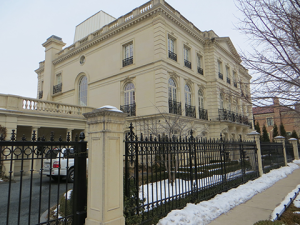
Chicago’s North Burling Street, 2005-2015: From Public Housing to Mega-mansions
By Euan Hague
On Wednesday 30 March 2011, demolition began at 1230 North Burling Street, the last remaining high-rise block of public housing of the Cabrini-Green complex that, at its peak, had been home to over 15,000 people. The 23 high rise public housing blocks of Cabrini-Green, built between 1958 and 1962 and ranging from seven to nineteen floors in height, came to symbolize all that was bad about public housing, not just in Chicago but in the United States more generally. Cabrini-Green, like all of Chicago’s public housing, was conceived, designed, constructed and administered by the Chicago Housing Authority (CHA). In 1969 the CHA was found by the Supreme Court to have acted unconstitutionally in using race to determine where to build, and how to allocate apartments in, the city’s public housing projects. Continue Reading.

Surveillance and Policing in Chicago…and its Discontents
By Brendan McQuade
In the aftermath of the 2013 Boston Marathon Bombing, Chicago received national attention for its comprehensive network of surveillance cameras. One of the first U.S. cities to make extensive use of surveillance cameras, beginning in June 2003, the Chicago Police had launched “Operation Disruption,” a multi-phased plan to install “blue-light” Police Observation Device cameras (PODs) in high crime areas. Able to rotate 360 degree and zoom to a fine level of detail, bullet proof, operable in any weather condition, these cameras record continuously and switch into night vision mode after dark. They are used to monitor street crimes and direct police deployment. Continue Reading.
[Focus on Chicago is an on-going series curated by the Local Arrangements Committee to provide insight on and understanding of the geographies of Chicago]
NEWS
 Give Back By Becoming a GeoMentor
Give Back By Becoming a GeoMentor
AAG Announces ConnectED GeoMentors Program
Esri and the Association of American Geographers (AAG) are working together to develop a nationwide network of GeoMentors to support the U.S. Department of Education’s ConnectED Program, for which Esri has agreed to donate free GIS software to all K–12 schools in the U.S. GeoMentors will help schools and teachers introduce GIS and associated geographic concepts into classrooms across the country. Learn More.
2015 Honorary Geographer: Peter Bol
The Association of American Geographers has named Peter Bol as its 2015 Honorary Geographer. Bol is the Vice Provost for Advances in Learning and the Charles H. Carswell Professor of East Asian Languages and Civilizations at Harvard University. In making its selection, the AAG recognized Bol’s leadership role and engagement with the AAG to build university-wide support for geospatial analysis in teaching and research at Harvard University, and the resulting establishment of the Harvard Center for Geographic Analysis, of which he was its first and extraordinarily successful director. Learn More.
AAG Selects Paul Knox for AAG Globe Book Award
The AAG Globe Book Award for Public Understanding of Geography will be given for a book written or co-authored by a geographer that conveys most powerfully the nature and importance of geography to the non-academic world. This distinction for 2015 is presented to Paul Knox (editor) for the book, Atlas of Cities, published by Princeton University Press. Learn More.
AAG Members Elect New Councillors and Committee Members
A list of newly elected officers and committee members is available online. Learn more.
MEMBER & DEPARTMENT NEWS
USGS Scientist Roger Sayre Honored for Public Service with Esri Award
U.S. Geological Survey scientist Dr. Roger Sayre was honored with the annual Making A Difference Award at the Esri Federal Users Conference in Washington, DC, on February 9, 2015. The award recognized Sayre’s vision and leadership in recent collaboration between the USGS and Esri to produce a new map of global ecosystems at an unprecedented level of detail. Read More.
AAG Member David López-Carr Named AAAS Fellow for 2014
AAG member and UC Santa Barbara Geography Professor David López-Carr has been named a fellow of the American Association for the Advancement of Science (AAAS) for 2014. He is being recognized for advancing the scientific understanding of the couple process of human population dynamics and environmental change. Dr. López-Carr’s work focuses on population dynamics, particularly the links between migration and fertility and terrestrial and marine resource use in Latin America and between population and health vulnerabilities to climate change in America. He integrates diverse data sources from the United Nations and World Bank, working with anything from socioeconomic and demographic data to remotely sensed imagery with field-based surveys. Read More.
IN MEMORIAM
Chiao-Min Hsieh
James W. Merchant
Richard R. Randall
Stephen E. White
POLICY UPDATES
White House Announces New STEM Education Funds
The following news piece from AAAS details an Obama Administration STEM initiative. The AAG has been working hard to ensure that federal programs focused on STEM science and education opportunities are open to geographers and GIScientists.
During the White House Science Fair on March 23, President Obama announced a commitment to invest over $240 million to encourage students in the STEM fields, as part of his “Educate to Innovate” campaign. New funding will include: $150 million fund to help early-career scientists stay on track; $90 million to the “Let Everyone Dream” campaign, which aims to increase STEM opportunities for underrepresented youth; and $25 million for a competition within the Department of Energy to inspire students to create media about science and literacy. Read More.
Public Access to NSF-Funded Research
On March 18, the National Science Foundation (NSF) announced its plan to promote public access to the results of NSF-sponsored research. While the agency is not building its own public archive, NSF states that accepted manuscripts or versions of record must be publicly available in an approved repository within 12 months of publication. Availability signifies that any user can download, read, and analyze the data free of charge. This will apply to “new awards resulting from proposals submitted, or due, on or after the effective date of the Proposal & Award Policies & Procedures Guide (PAPPG) that will be issued in January 2016.” Read More.
PUBLICATIONS
Call for Papers: GeoHumanities
GeoHumanities is a new journal being launched by the Association of American Geographers and will be published by Taylor and Francis. Its editors are Tim Cresswell (Northeastern University, Boston) and Deborah Dixon (University of Glasgow). GeoHumanities publishes original peer-reviewed articles that span conceptual and methodological debates in geography and the humanities; critical reflections on analog and digital artistic productions; and new scholarly interactions occurring at the intersections of geography and multiple humanities disciplines. Read More.
MORE HEADLINES
Op-Ed: A Graduate Student Perspective on Geography
By Courtney Reents
I started my first semester as a geography graduate student with a geographic background comprised only of GIS and remote sensing, exclusively covering geospatial technology and its applications with little consideration for the discipline that nurtured its growth. Prior to taking this course on contemporary geographic thought, I would have dismissed references to various paradigms and worldviews, to determinism and mechanistic materialism and the quantitative revolution, as the purview of philosophy and meta-theory, relics of the irrelevant discourses of another century. I was operating under the mistaken assumption that the way things are is the way they’ve always been, and that no particular sequence of historical events was required to forge the discipline of Geography as it exists today. Read More.
EVENTS CALENDER
- 2015 AAG Annual Meeting, Chicago, IL, April 21-25
- Venice International Conference on Waterscapes and Historic Canals as a Cultural Heritage, Venice, Italy, May 14-15
- GeoComputation 2015, Dallas, TX, May 20-23
- 21st Annual California GIS Conference, Sacramento, CA, June 1-3
- IMAGIN 2015 Annual Conference, Traverse City, MI, June 7-9
- Annual Conference of the European Society for Literature, Science and the Arts 2015, Malta, June 15-18
Submit News to the AAG Newsletter. To share your news, submit announcements to newsletter [at] aag [dot] org.


